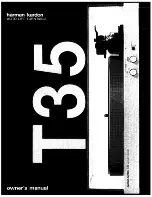
•
How much does the speed
change?
•
What is the rate and pattern of
the change?
In a turntable, the amount of the
change in the rotational speed is
directly proportional to the frequency
shift in the audio output. Therefore for
example, if the rotational speed
decreases by 1% (for example, from 33
1/3 RPM to exactly 33 RPM), the audio
output will drop in frequency by 1% (so
a 440 Hz tone will be played as a
440*0.99 = 435.6 Hz tone). Whether
this is audible is dependent on
di
ff
erent factors including
•
the rate of change to the new
speed
(a 1% change 4 times a second is
much easier to hear than a 1%
change lasting 1 hour)
•
the listener’s abilities
(for example, a person with
“absolute pitch” may be able to
recognise the change)
•
the audio signal
(It is easier to detect a frequency
shift of a single, long tone such
as a note on a piano or pipe
organ than it is of a short sound
like a strike of claves or a sound
with many enharmonic
frequencies such as a snare
drum.)
In an e
ff
ort to simplify the specification
of stability in analogue playback
equipment such as turntables, four
di
ff
erent classifications are used, each
corresponding to di
ff
erent rates of
change. These are drift, wow, flutter,
and scrape, the two most popular of
which are wow and flutter, and are
typically grouped into one value to
represent them.
Drift
Frequency
drift
is the tendency of a
playback device’s speed to change
over time very slowly. Any variation
that happens slower than once every 2
seconds (in other words, with a
modulation frequency
of less than 0.5
Hz) is considered to be drift. This is
typically caused by changes such as
temperature (as the playback device
heats up) or variations in the power
supply (due to changes in the mains
supply, which can vary with changing
loads throughout the day).
Wow
Wow
is a modulation in the speed
ranging from once every 2 seconds to
6 times a second (0.5 Hz to 6 Hz). Note
that, for a turntable, the rotational
speed of the disc is within this range.
(At 33 1/3 RPM: 1 revolution every 1.8
seconds is equal to approximately
0.556 Hz.)
Flutter
Flutter
describes a modulation in the
speed ranging from 6 to 100 times a
second (6 Hz to 100 Hz).
Scrape
Scrape
or
scrape flutter
describes
changes in the speed that are higher
than 100 Hz. This is typically only a
problem with analogue tape decks
(caused by the magnetic tape sticking
and slipping on components in its path)
and is not often used when classifying
turntable performance.
Measurement and Weighting
The easiest accurate method to
measure the stability of the turntable’s
speed within the range of Wow and
Flutter is to follow one of the standard
methods (of which there are many, but
they are all similar
). A special
measurement disc containing a sine
tone, usually with a frequency of 3150
Hz is played to a measurement device
which then does a frequency analysis
of the signal. In a perfect system, the
result would be a 3150 Hz sine tone. In
practice, however, the frequency of the
tone varies over time, and it is this
variation that is measured and
analysed.
There is general agreement that we
are particularly sensitive to a
modulation in frequency of about 4 Hz
(4 cycles per second) applied to many
audio signals. As the modulation gets
slower or faster, we are less sensitive
to it, as was illustrated in the example
above: (a 1% change 4 times a second
is much easier to hear than a 1%
change lasting 1 hour).
So, for example, if the analysis of the
3150 Hz tone shows that it varies by
±
1% at a frequency of 4 Hz, then this
will have a bigger impact on the result
than if it varies by
±
1% at a frequency
of 0.1 Hz or 40 Hz. The amount of
impact the measurement at any given
modulation frequency has on the total
result is shown as a “weighting curve”
in Figure
0.1
1
10
100
200
Modulation Frequency (Hz)
-50
-45
-40
-35
-30
-25
-20
-15
-10
-5
0
5
Response of weighting filter (dB)
Weighting of the Wow and Flutter measurement result: AES6-2008 (r2012)
Figure 4.2: Weighting applied to the
Wow and Flutter measurement in most
standard methods. See the text for an
explanation.
As can be seen in this curve, a
modulation at 4 Hz has a much bigger
weight (or impact) on the final result
than a modulation at 0.315 Hz or at
140 Hz, where a 20 dB attenuation is
applied to their contribution to the
total result. Since attenuating a value
by 20 dB is the same as dividing it by
10; a
±
1% modulation of the 3150Hz
tone at 4 Hz will produce the same
result as a
±
10% modulation of the
3150 Hz tone at 140 Hz, for example.
This shows just one example of why
3
Examples of these standards are AES6-2008, CCIR 409-3, DIN 45507, and IEC-386
15





































